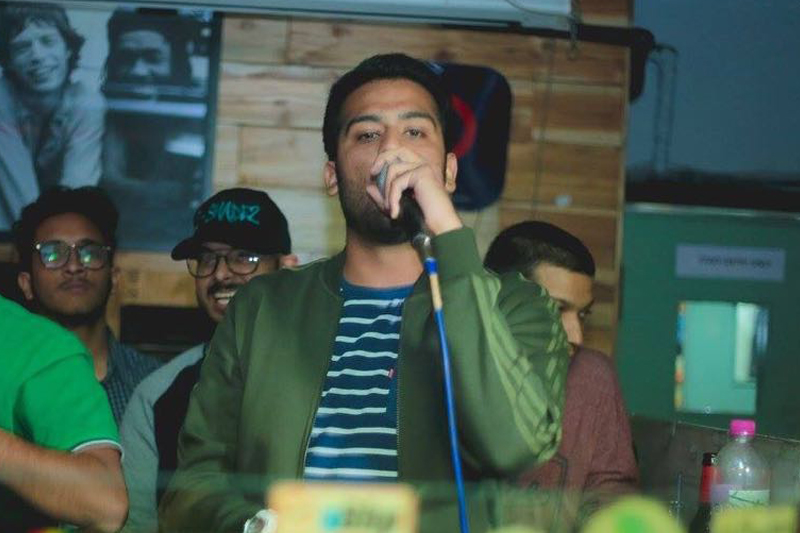
In a land far far away from the maddening crowds, sparkly club lights, auto corrected tunes, breathes a community of musicians eagerly waiting to be heard. Their music – a rant, a take or just an outlet to break silence, rests unheard overshadowed by the fancy fetish of the never ceasing Delhi. While their geographical counterparts rule turntables week after week, indie crusaders of Underground Rap have started a silent revolution in the city.
The origin of Rap music traces its history back to South Bronx (New York) in the 1960s-70s. It began as an ice breaker between African-American, Puerto Rican and other ethnic groups that densely populated the neighborhood. Ghetto Brothers were one of the firsts to plug in amplifiers and speakers into lampposts and experiment with the beats, breaking and emceeing (rapping). However, India’s rendezvous with rap began stuttering only by late 90s; where Baba Sehgal and Devang Patel are often credited for its commercial introduction to the masses.
Keepsake, a young artist from Delhi’s underground rap scene known for the realness in his music talks about how Western rap heavily influenced its Indian counterpart. “Devang’s Meri Marzi and Stop That were inspired by songs such as Apache Indian’s Arranged Marriage. Around that time, Baba Sehgal was also gaining fame for his uncanny rap lyrics and songs like Thanda Thanda Pani, which was completely inspired by Vanilla Ice’s Ice Ice Baby which in turn was sampled from Under Pressure by Queens.”
KRSNA, a first generation rap artist based in Delhi gained respect in the Indie music industry without going down the route of clocking in a quintessential bollywood-tune-to-fame. Talking about the dichotomy between the arts and the commercials of this genre he says, “There is no denying the monetary success of artists such as Raftaar and Badshah. Rising from the same community, they have gone far and I would want the same recognition. However, I can’t compromise with my content.”
With a Universal Music contract under his belt, a hit solo album Sellout, KRSNA’s idea of rap did not change with time. According to him, the only way Hip Hop succeeds is when it penetrates from the grassroots. “Rap is a tool to vent out. It developed through people with angst; people with a story that needed to get out there. In India, for the most of early 2000s, it penetrated top down because most of the rap songs were in English and only folks from privileged backgrounds had access to these. It took years before people started appreciating vernacular rap and that’s when the trigger happened. It is spreading like wildfire now because it’s accessible,” adds KRSNA.
Punjabi, Urdu, Hindi, English and maybe more; there is no dearth of language in the contemporary raps of Delhi. With no apprehensions and barriers in their minds, the artists are using all their might to write lyrics and create music that hits home. Themes like self, politics, social issues find frames in almost all their works, where meaning takes centre, rather centre creating meanings.
“Underground Rap or Rap in general is on the rise. Every morning brings in a new name, ready to be explored. The artists are working their way up, uninhibited. Events by rap communities like Spit Dope Inc. provide platforms that didn’t exist for older generations. To be honest, these are the best times that the underground rap community has observed,” says Sukrit Chopra, a well-recognized name in the rap-underbelly of the capital. His cyphered jams and wins in the battles have had his listeners hooked.
Talking about the intricate granularities of creating a rap song, Noran Beatz, a Delhi-based beat producer explains how lyrics are the heart of a rap and the beat its soul. One can listen to a rap without a beat, but there will always be something missing. When asked what goes into the production of a beat he says, “Themes. One has to decide what vibe or theme based beat they are making, beforehand. It is only after that, the producer understands the vibe and the rapper initiates, can the sound processing begin. Once that is sorted, we work towards sequences. What is most important is the final stage where leveling of each sound is necessary, so that the whole beat doesn’t sound cluttered.”

Noran Beatz
The advent of this genre in Delhi is not a new phenomenon. Keepsake recalls how as a child he was overawed by a lavish house in the famous Greater Kailash. “I soon found out that it was the house of Sameer Hussain, son of famous Indian beautician Shahnaaz Hussain. He was one of India’s very first Gangsta rappers who had a record deal and an album called Gunda Basti under his name. Unfortunately, he passed away in 2008. Had he been alive, he would have been listed in top Indian artists.”
Gauren Bharadwaj, a rap enthusiast in Delhi, lets out an ecstatic “YES” when asked if the Underground Rap in the capital is any good. “Initially, the raps in Delhi were broken, abrupt. It was all about catching up to the beat. It lacked the craft, the depth a rapper needed to channelize. Today, things have changed for good. We have more rappers who understand the art. The way things have evolved in such a short span, it is only going to get bigger and better,” he says.
As our earphones slowly tune into the lyrical beats of these young artists, the pool of talent untouched and unexplored leave us much baffled. Rap, a much personal form of music has its core stuck into the bones of its maker. The beats are dropping in the city now than ever before. Good, bad, you be the judge.

